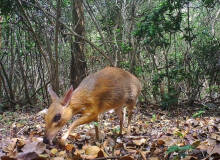
Vietnamese Mousedeer (scientific name: Tragulus versicolor) English Silver-backed Chevrotain, Vietnamese Mousedeer, French Chevrotain du Vietnam, no subspecies.Both male and female Vietnamese mouse deer are territorial, marking their territory with feces, urine, and submandibular gland secretions. T...
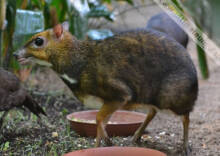
Philippine Mouse Deer (scientific name: Tragulus nigricans) English Balabac Mouse Deer, Balabac Chevrotain, Philippine Mouse-deer, French Chevrotain de Balbac, no subspecies.Philippine mouse deer are territorial in both sexes, with males marking their small, permanent territories with feces, urine,...
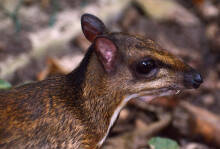
The Greater Mousedeer (scientific name: Tragulus napu) is called Greater Oriental Chevrotain, Balabac Chevrotain, Greater Indo-Malayan Chevrotain, Greater Mousedeer, Larger Malay Chevrotain, Larger Mousedeer, Napu in English, Chevrotain napu, Grand tragul malais in French, and Napoh in Malay. There...
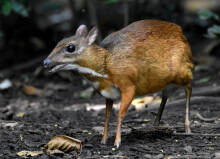
Lesser Mousedeer (scientific name: Tragulus kanchil) English Lesser Oriental Chevrotain, Lesser Indo-Malayan Chevrotain, Lesser Malay Chevrotain, Lesser Mousedeer, Mouse Deer, French Chevrotain kanchil, Petit tragul malais, Indonesian Kanchil, has 30 subspecies, slightly larger than a hare. The mous...

Javan Mousedeer (scientific name: Tragulus javanicus) English Javan Chevrotain, Java Mousedeer, Javan Mousedeer, Kanchil, Lesser Mouse Deer, French Chevrotain de Java, Petit tragul malais, no subspecies.In the early classification, the Javan mouse deer was classified as a large mouse deer (now calle...
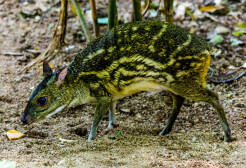
Spotted Mouse Deer (scientific name: Moschiola meminna) English White-spotted Chevrotain, Chevrotain, Indian Mouse Deer, Indian Spotted Chevrotain, White-spotted Mousedeer, French Tragule d'Inde, Spanish Meminna, no subspecies.In 2005, Groves and Meijaard revised the name "Moschiola meminna...
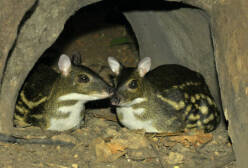
The yellow-striped mouse deer (scientific name: Moschiola kathygre) has no subspecies. It mainly eats fruits that fall from trees, and other foods include young leaves, shrubs, and young branches.The golden brown body and yellow stripes and markings of the yellow-striped chevrotain visually distingu...
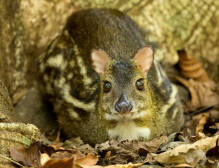
Indian Chevrotain (scientific name: Moschiola indica) is also known as Indian Chevrotain, Indian Mouse Deer, Indian Mousedeer, Indian Spotted Chevrotain. It has no subspecies and is the largest member of the genus Moschiola.The Indian spotted chevrotain is a shy and secretive species. Like other for...
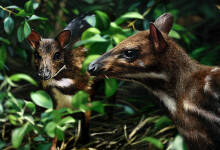
Water Chevrotain [shuǐ xī lù] (scientific name: Hyemoschus aquaticus) English: Water Chevrotain, French: Chevrotain Aquatique, Spanish: Antilope Amizclero Enano de Agua, German: Hirschferkel, no subspecies, is the largest member of the family Hyemoschus.Water deer females are sedentary, occupying...

The foreign name of the yellow-bellied tragopan is Cabot's Tragopan, and there are 2 subspecies.The yellow-bellied tragopan is good at hiding and running. It often moves in dense undergrowth and grass under the forest. It generally does not take off unless it has to. They often move in small gro...

The foreign name of the red-bellied tragopan is Temminck's tragopan, and there is no subspecies.The red-bellied tragopan likes to act alone, but occasionally forms small groups in winter. It mainly feeds on the tender shoots, leaves, green leaves, flowers, fruits and seeds of trees, shrubs, bamb...
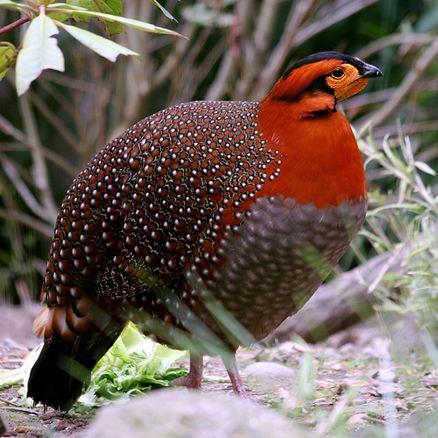
The Blyth's Tragopan is called Blyth's Tragopan in English, and has two subspecies.The Blyth's Tragopan is alert by nature, good at running, and generally rarely flies. When frightened, they often run fast or hide in dense forests and bushes, and only fly away when they have to. But the...
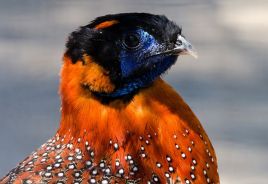
The foreign name of the red-breasted tragopan is Satyr Tragopan, and there is no subspecies.The red-breasted tragopan mainly forages in the early morning and dusk, and likes to hide. Most of the time, it hides in the deep mountains and dense forests where few people go. It is cautious in its movemen...
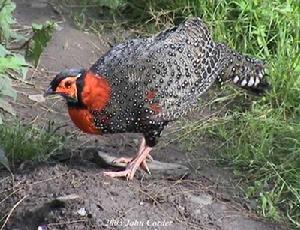
The foreign name of the black-headed tragopan is Western Tragopan, and there is no subspecies.The black-headed tragopan likes to move alone and forms small groups in winter. It has weak flying and dispersal abilities, and relatively poor ability to avoid natural enemies. It lives in dense forests, a...